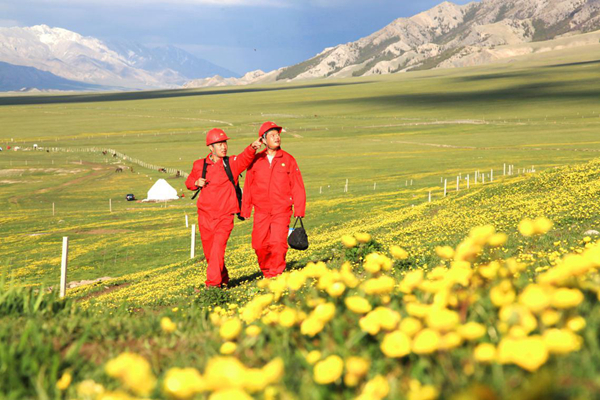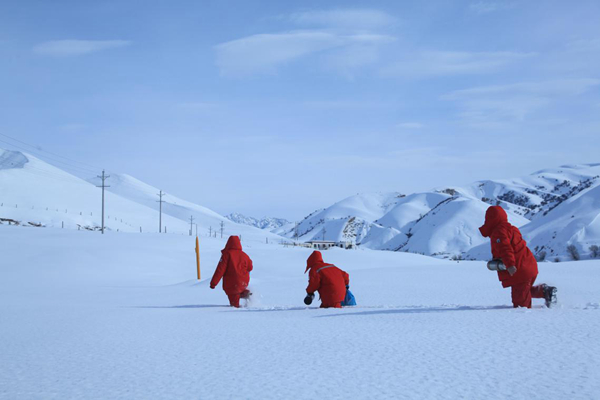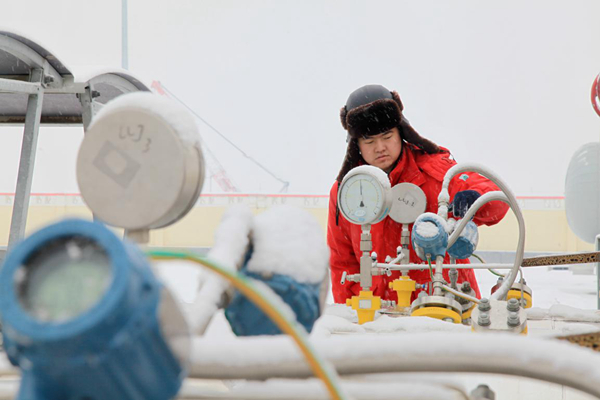[SOEs in the B&R projects] Natural gas pipeline benefits Belt and Road regions
There is a compressor station on the China-Central Asia natural gas pipeline in Horgos, Xinjiang Uygur autonomous region, where employees of China National Petroleum Corporation (CNPC) have been working for years.
The Horgos compressor station is the chief station on the China-Central Asia gas pipeline, the chief station on driving the second and third lines of China’s west-to-east gas transmission project and the first cross-border natural gas pipeline in China.

The operation area of the Horgos compressor station [Photo by Lei Yuchuan/News Center of SASAC]
The station ensures the stable operation of the whole line and the energy security of billions of households.
Adjoining the "bridgehead" of the new Silk Road Economic Belt and a first-class port -- the Horgos special economic zone -- the compressor station is dubbed "the first gateway of China's energy channel" because of its strategic importance, favorable location and industrial and economic values.

CNPC workers patrol the pipeline. [Photo/sasac.gov.cn]
As a landmark project for the Western China Development Strategy, China's west-to-east gas transmission project can deliver clean natural gas to about 500 million people in 28 provincial areas.
Line C of the China-Central Asia natural gas pipeline is another energy artery built to further meet domestic demands of clean energy by CNPC and its partners.
It starts from the Turkmen-Uzbek border and runs through three countries. Its 1,800-km section outside China includes a 1,300-km section in Kazakhstan. The construction of the project has greatly increased local tax revenue.
The project has also built natural gas stations along the line, offering clean energy and more job opportunities for locals.
In the early periods of the founding of the People's Republic of China, the Chinese oil drillers represented by the "iron man" Wang Jinxi completely smashed the hat of China as a backward country with poor oil in only three years, and cultivated the spirit of "patriotism, entrepreneurship, truth-seeking and dedication". It is also the spirit of Chinese central state-owned enterprises.
In 2009 the world's longest natural gas pipeline entered China through Horgos. Its section outside China was called the Central Asia natural gas pipeline while the section in China was called the second line of the west-to-east gas transmission project. In 2013, the 7,378-km-long third line of the west-to-east gas transmission project also entered China through Horgos.
The saying "The post responsibility is always heavier than pipeline pressure" vividly mirrors the CNPC employees’ dedication to their work.
"At the Horgos station, more than 100 million cubic meters of natural gas go downstream everyday in winter, 300 cubic meters in just a moment or two, which is enough for the consumption of a three-member family in one year," said Yu Xuefeng, Director of the Horgos operation area, adding that the designed pressure of the second and third lines of China’s west-to-east gas transmission project is 12 MPa, 120 times standard atmospheric pressure. It has the highest gas pressure in the world.
A total of 46 CNPC workers with an average age of 30 brave the huge temperature difference between day and night and patrol the complex terrain to maintain the equipment and transmission line.
The Guozigou area is the most challenging section to patrol. There are 38 curves in one 2-km stretch with a height difference of 1,000 meters.

Ma Long, an engineer checks the equipment at the Horgos compressor station. [Photo by Lei Yuchuan/News Center of SASAC]
According to Ma Long, an engineer at the Horgos compressor station, the slope can reach as high as 75 degrees.
The patrols brave piercing cold weather in winter to ensure the stable and safe transmission of natural gas.

Patrols walk in above knee-high snow. [Photo/sasac.gov.cn]
In 2010, the extreme cold in Xinjiang froze the upper reaches of the pipeline. Workers sprayed boiling water in shifts to melt the ice in the pipe for three consecutive days, Ma recalled.
With the advancement of the Belt and Road Initiative, natural gas from Central Asia will serve as a key engine for development. The workers of CNPC are devoted to overcoming difficulties and supplying clean energy to other parts of the country.

A staff worker removes snow from a pressure gauge. [Photo/sasac.gov.cn]
(Executive editor: Li Shuling)



